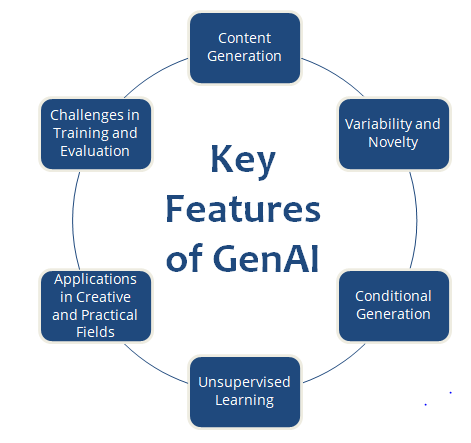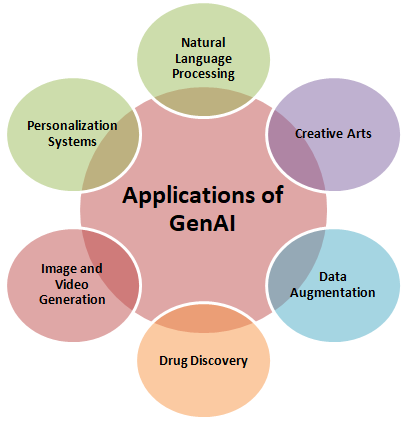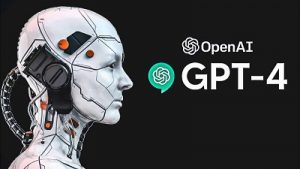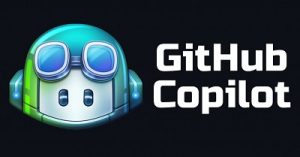
GenAI: The Next Generation of AI Technology
We are on the cusp of a new era in artificial intelligence (AI) technology, experiencing a significant leap forward with the emergence of Generative AI (GenAI). GenAI is an AI system that can generate new content or information without the need for direct human intervention. This technology has the potential to revolutionize various industries and transform the way we interact with software applications. In this blog, we will understand the basics of GenAI, its key features, and the impacts of GenAI on the future of AI technology.
GenAI or Generative AI
GenAI, also known as Generative Artificial Intelligence, is a rapidly growing field of artificial intelligence focused on creating new content, such as images, text, audio, videos, and even 3D models. It utilizes a specific type of AI model called a generative model, which learns the patterns and structures of its training data and uses that knowledge to create new data with similar characteristics. Let’s understand the GenAI concept in simple terms.
Imagine you have a magic paintbrush that can create anything you can think of. That's kind of what Generative AI is like! It's a type of artificial intelligence that can generate brand-new content, like:
Images: Think realistic landscapes, portraits, or even entirely fantastical creatures.
Text: Articles, poems, scripts, code, music... anything you can write down.
Audio: Music, sound effects, even voices speaking different languages.
Data: Missing information in datasets, synthetic data for testing purposes, etc.
Generative AI does this by learning from huge amounts of existing data. Imagine looking at millions of photos of cats and dogs. Eventually, you'd understand what makes a cat different from a dog, right? Generative AI models do the same, but on a much larger scale and with much more complex data. They learn the patterns and rules of different types of content and then use that knowledge to create something new.
Key Features of GenAI
Generative AI or GenAI, a subset of artificial intelligence, is characterized by several key features that distinguish it from other AI techniques. Some of the key features of generative AI include:

Content Generation: Generative AI is designed to create original content, such as images, text, audio, and video, often in a manner that mimics human creativity and expression.
Variability and Novelty: With each use, generative AI models produce diverse and novel outputs that allow to generation of unique and diverse content for various purposes.
Conditional Generation: By conditioning on specific input data or constraints, Generative AI is capable of creating content that meets certain criteria or follows predefined patterns.
Unsupervised Learning: Generative AI models can learn from unlabeled data and allow them to capture and model the underlying structure of the data without explicit supervision.
Applications in Creative and Practical Fields: The applications of generative AI are vast and diverse and span across various fields such as art, design, music, storytelling, and data synthesis. Additionally, it also has practical use cases like generating synthetic data for machine learning and data augmentation.
Challenges in Training and Evaluation: Training and evaluating generative AI models come with several distinct challenges, including issues like mode collapse, instability during training, and the requirement for diverse and efficient evaluation metrics.
These features make generative AI a powerful and versatile tool for a wide range of applications, with the potential to drive innovation and creativity in various domains.
Applications of GenAI
GenAI has a wide range of applications across various industries. Some of the key applications of Generative AI include:
Natural Language Processing: Natural language processing (NLP) applications, like chatbots and virtual assistants, can be enhanced using generative AI. By generating more human-like responses, these applications can provide a more seamless user experience.
Creative Arts: It is possible to create original artwork, music, or other forms of creative content with the help of digitally generated AI. For example, music generated by AI can find applications in video games, films, and various other forms of media.
Data Augmentation: By using generative AI, you can create synthetic data, which can be used to enhance existing datasets for training machine learning algorithms. This method can improve machine learning models more quickly, and the need for large amounts of real-world data can be reduced.
Drug Discovery: GenAI can be used to generate molecular structures and predict the properties of potential drugs. This has applications in pharmaceutical research and drug discovery.
Image and Video Generation: You can create realistic images and videos using GenAI, which has applications in areas such as virtual reality, gaming, and visual effects.
Personalization and Recommendation Systems: With the assistance of GenAI, users can receive personalized content and recommendations based on their preferences and behavior. The technology can be used in e-commerce, content delivery, and marketing.
Also Read: Artificial Intelligence and Natural Language Processing: A Powerful Combination

These are just a few examples of the many applications of GenAI. As the technology continues to evolve, it is expected to have an even greater impact on various industries, driving innovation and progress in the field of AI.
GenAI Tools To Look In 2024
Several GenAI tools will have a significant impact across diverse industries by 2024. Some of the key tools to look out for include:
1. GPT-4 (Generative Pre-trained Transformer 4)

GPT-4 builds on the success of its predecessors to push the boundaries of natural language generation and comprehension. It will be able to generate, translate, and summarize texts more efficiently.
2. DALL-E 2

The tool should improve image generation from textual descriptions as a successor to the original DALL-E. It may have enhanced capabilities in creating diverse and high-fidelity visual content based on natural language input.
3. CLIP (Contrastive Language-Image Pretraining)
CLIP AI is a generative AI model that can understand and generate multimodal content, such as images and text. It is trained to understand the relationship between images and their textual descriptions making it a valuable tool for image search, image captioning, and visual question answering.
4. MidJourney

Midjourney is an AI art generator that uses text prompts to create stunning visuals. It excels in generating surreal, dreamlike images with a unique artistic touch. Users can control the style and level of detail. And make it popular for artists, designers, and anyone interested in exploring the intersection of AI and art.
5. Github Copilot

This AI-powered extension for code editors helps developers write code faster and more efficiently. It can suggest code completions, generate different coding styles, and even help with debugging. Github Copilot is a valuable tool for programmers of all skill levels.
6. Synthesia

Synthesia is a platform for creating realistic AI-powered videos. You can choose a virtual actor, type your script, and watch Synthesia bring your words to life. This makes it ideal for creating explainer videos, educational content, and even personalized marketing campaigns.
7. Scribe
Scribe is an AI writing assistant that excels in summarizing articles, crafting reports, and aiding academic writing. It empowers journalists, students, and professionals, streamlining research and writing, and supercharging productivity. However, intricate creative writing may still require a human touch for precision.
8. Duet AI
Duet AI is a generative AI tool that focuses on natural language processing and understanding. The system facilitates human-AI collaboration by providing intelligent assistance with tasks such as writing, summarizing, and creating content.
9. Cohere Generate

This AI tool is a language generation model that leverages generative AI to produce human-like text based on prompts and context. It can generate articles, stories, and technical documentation as well as code and other forms of written content.
10. AlphaCode
Developers find AlphaCode to be a game-changing coding assistant that utilizes generative AI to enhance their work. AlphaCode is exceptional in writing code, resolving bugs, and proposing the most effective programming solutions. Its ability to automate tasks, speed up workflows, and facilitate language acquisition has made it a popular choice among developers.
Impact of GenAI on the Future of AI Technology
Generative AI (GenAI) has had a profound impact on the field of AI technology accelerating progress in various areas and opening up new possibilities. Here's a breakdown of its key impacts:
1. Increased Efficiency and Speed of Development
GenAI models can automate tedious tasks such as data labeling and model training, significantly reducing the time and resources needed to develop new AI solutions.
For example, GANs can generate large amounts of synthetic data and allow researchers to train AI models on datasets that would otherwise be too expensive or time-consuming to create. This efficiency boost allows researchers to experiment with more ideas and iterate on their models faster leading to rapid advancements in AI technology.
2. Enhanced Creativity and Exploration
With its ability to generate novel ideas and concepts, GenAI has the potential to contribute to breakthroughs in different fields that may have been difficult for humans to conceive.
For example, LLMs, which are advanced AI tools, can help researchers come up with new ideas for science or product design. By exploring new areas, AI can help speed up innovation by allowing researchers to do things that were not previously possible.
Also Read: Assign Tasks to LLMs in Python
3. Improved Personalization and Customization
By catering to individual user preferences, GenAI can produce customized content and experiences that promote more engaging and immersive interactions with AI systems.
For example, chatbots powered by LLMs can personalize their communication style to each user, leading to more natural and satisfying conversations. This personalization enhances the user experience and encourages wider adoption of AI technologies.
4. Democratization of AI Development
GenAI tools and platforms are becoming increasingly accessible, even for users with limited technical expertise. This allows more people to participate in AI development, leading to a more diverse and innovative AI ecosystem.
For example, platforms like RunwayML and Midjourney allow users to create images and videos without needing to write code, making AI technology more accessible to artists and designers.
5. Addressing Bias and Fairness Concerns
By using GenAI models, we can identify and mitigate bias in AI systems, which leads to fairer and more ethical outcomes. For example, researchers are developing techniques to de-bias datasets and train AI models that are fair and unbiased. This focus on ethical AI development is crucial for ensuring that AI benefits all members of society.
6. New Research Directions and Applications
GenAI is opening up new research directions and applications across various fields, from material science and drug discovery to art and entertainment. For example, researchers use GANs to generate new materials with desired properties, while LLMs are used to write scripts and compose music. These innovative applications push the boundaries of what's possible with AI and pave the way for a future where AI is deeply integrated into our lives.
7. Collaboration with Human Experts
GenAI is not intended to replace human intelligence but rather to complement it. By combining the strengths of AI and human expertise, we can achieve better outcomes in various fields.
For example, AI-powered design tools can assist designers in generating creative ideas, while human experts can provide feedback and refine the designs to ensure they are functional and aesthetically pleasing.
8. Potential Risks and Challenges
While GenAI offers significant benefits, it also raises important ethical concerns, such as the potential for misuse, job displacement, and bias. To ensure that GenAI is used responsibly and benefits society as a whole, robust safeguards and ethical guidelines are necessary.
Overall, Generative AI is a powerful tool with the potential to revolutionize the field of AI technology. By leveraging its capabilities responsibly and ethically, we can harness the power of AI to create a better future for all.
Final Words
GenAI represents a transformative force in the world of AI technology and offers unprecedented creative potential and limitless possibilities. The future of GenAI is undoubtedly bright, holding the promise of transforming our world into one that is more creative, innovative, and interconnected.
I hope you found the information about GenAI insightful and valuable. If you're looking to unlock the potential of this transformative technology for your project, CodeTrade can help. We offer dedicated AI and ML developer resources to support your vision and drive innovation.
Stay tuned to CodeTrade's latest insights for cutting-edge tech updates and expert perspectives on how GenAI and other emerging technologies are shaping the future.